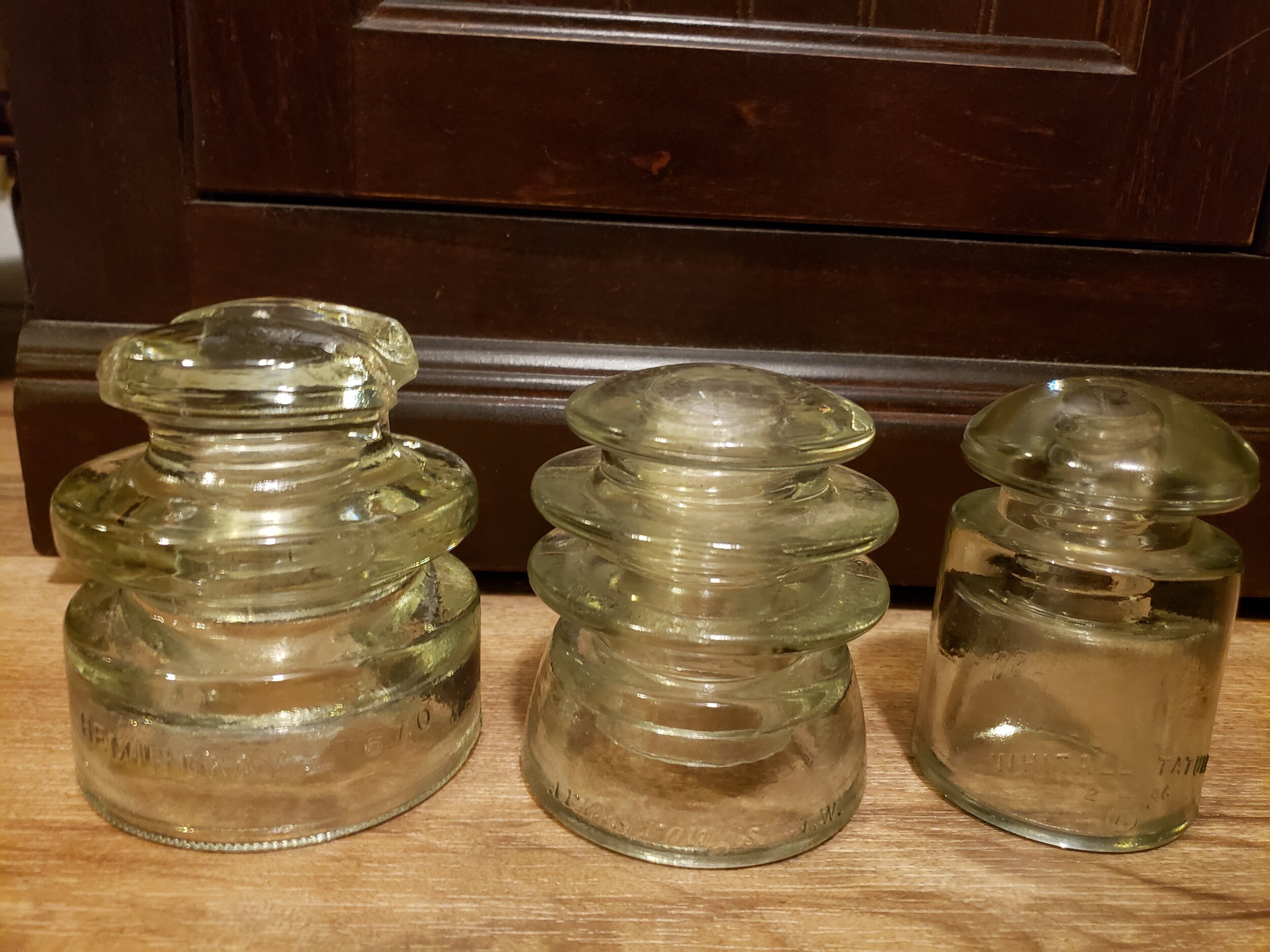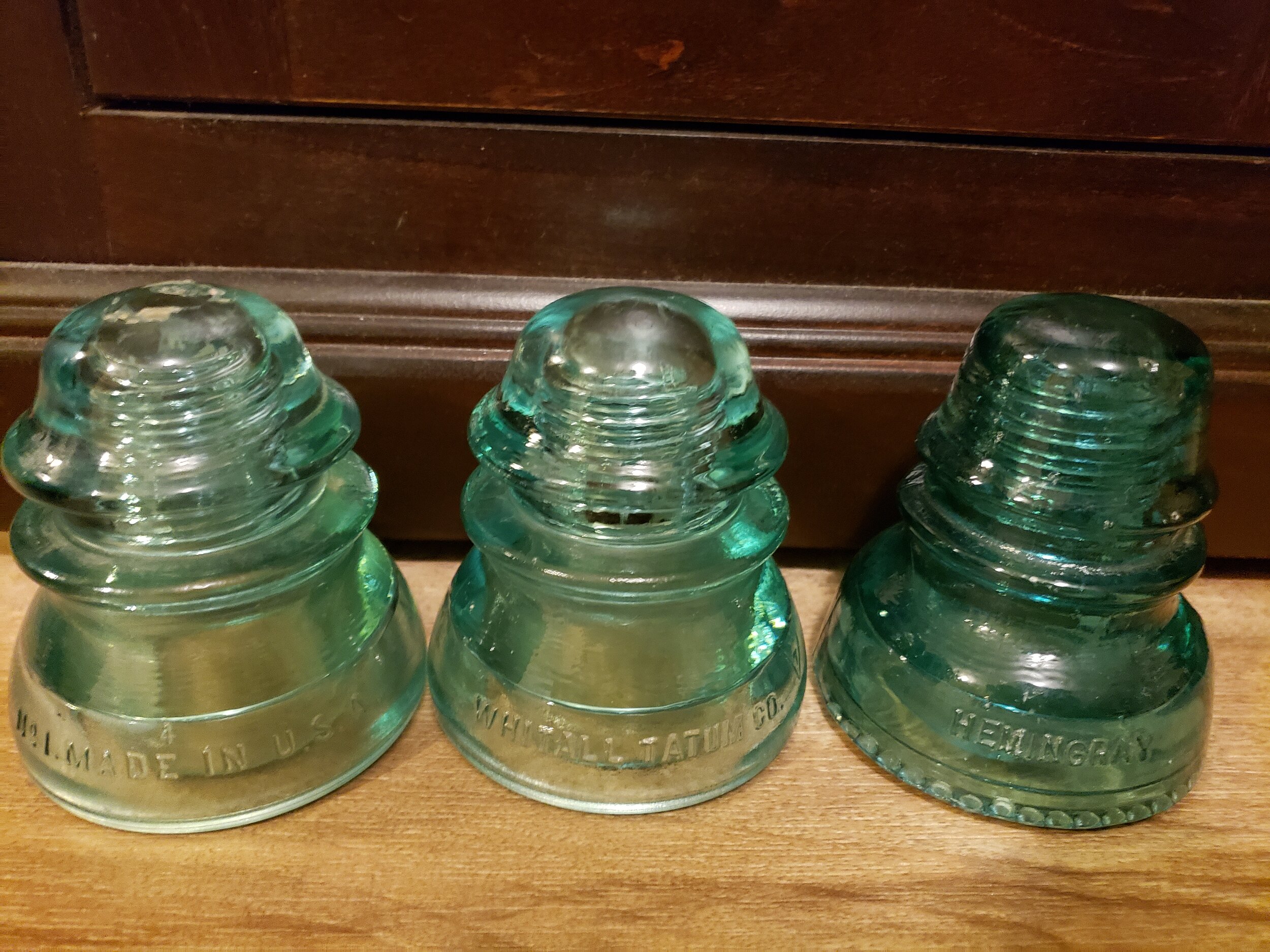Insulators
Whitall Tatum No 1 Clear Glass
Hemingray No 45 Clear Glass
Whitall Tatum Co. No 1 Aqua Glass
Insulators were originally designed to keep the wires linking telegraphs and telephones insulated from the wooden poles that held them aloft. In conjunction with the expansion of rural electrification in the early 20th century, there was a major boom in the manufacturing of insulators, with production peaking from the 1920s through the 1940s, when millions of Hemingray, Dominion, and Brookfield insulators were produced every year. Commonly made from glass or porcelain in a dazzling array of shapes and colors, including amber, cobalt blue, olive green (one shade is known among insulator collectors as “Seven-Up”), and royal purple, antique insulators are prized for their rarity and physical beauty. In collector’s circles, clear and aqua shades are considered generic because they result from the natural iron content present in most glassmaking materials. Some insulators were embossed with a manufacturer’s name and style number using engraved molds, yet many antique and vintage insulators were produced without any markings whatsoever. The earliest insulators were non-threaded “ram’s horn” and “glass block” designs, developed simultaneously for the growing network of telegraph lines in the United States. That effort was initiated in 1844, when inventor Samuel F. B. Morse connected Baltimore with Washington D.C. via a telegraph line that ran parallel to the Baltimore and Ohio Railroad’s tracks. Reportedly, the inspiration for the glass insulator came to an employee of Morse’s, Ezra Cornell, who was impressed by the design of a glass drawer pull he had encountered at a local inn. While there is no direct proof that this creation myth is true, some of the earliest insulators were known as bureau knobs or doorknobs. Soon the pinhole or pintype style was established, allowing a glass insulator to be attached to the top of a wood or metal pin using cloth coated in a tar-like substance. Threaded insulators were first patented by Louis Cauvet in 1865 as a more secure means of fastening the glass objects to the tops of wooden pins. This design is still considered standard for electrical insulators today. Use of porcelain and ceramic insulators spread during the late 19th century alongside higher-voltage electrical wires, like those required for home power lines, because the protective properties of porcelain proved superior to glass. Porcelain insulators were produced in a variety of colors to imitate their glass counterparts, ranging from deep blues and chocolate browns to bright yellows and greens. In addition, the shapes of these insulators were often dictated by the climate they would have to endure. For example, in the 1930s, two types of porcelain insulators were introduced for insulators used in foggy areas. The first featured multiple rings beneath the groove where the electrical wire rested, allowing moisture to drip away from the insulator's supporting pin. “Fog bowl” insulators, which resembled the stones used in curling, were designed to do the same thing. Antique insulators are typically identified by manufacturer, including H.G. Co., Pyrex, Brookfield, and Hemingray, as well as the Consolidated Design (CD) coding system. CD numbers describe the production location and shape of pintype glass insulators, with 10 – 99 representing battery rest insulators, 100 – 375 for North American threaded insulators, 376 – 699 for all foreign insulators, 700 – 799 for North American unthreaded insulators, and 1000 – 1199 for all other miscellaneous styles, including glass blocks, spools, and dead-end insulators. Within these broad categories, the shapes of vintage insulators are broken into many different variations describing the number of petticoats, drip points, skirt styles, wire grooves, and other features. Favored North American designs include the “Mickey Mouse” shape with two protruding glass ears and a saddle-groove form, as well as those made in lustrous carnival glass. The French created a distinctive “Gingerbread Man” form, with a rounded top and two pointed, upturned arms. The “T-Bar” design was also popular in Europe, and features outstretched, grooved arms, sometimes made with a square top, giving it a robot-like resemblance. Glass insulators were designed in a few basic forms depending on their specific electrical application. “Pony” insulators, often no more than 3 1/2 inches in height, were used for lower voltage lines, while “Power” insulators for high-voltage purposes were much larger, sometimes weighing more than 30 pounds. The most common style is the “Signal” variety, used for communication and secondary power lines. High-voltage “Cable” insulators are distinguished by their U-shape, which accommodated thick cable placement, while “Exchange” insulators were designed with multiple grooves to allow a primary line to pass through it and secondary branches to direct wire toward other locations. One of the most prolific insulator manufacturers in Canada was Dominon Glass Co., whereas Hemingray Glass Co. owned much of the market for insulators in the United States. Incorporated in 1870, Hemingray operated factories in Kentucky and Indiana, where it also produced other glass items, like bottles, fruit jars, kerosene lamps, and glassware. Hemingray created the largest stylistic variety of any manufacturer and purposefully designed colorful insulators, as opposed to the typical practice of recycling leftover batches of colored glass. The company's famous Hemingray No. 42 remains the best selling insulator of all time. via Collector’s Weekly
Whitall Tatum No 1 Clear Glass
Antiques
Antique refers to anything old, but it also refers to the rarity or beauty of an item from the past. Such items display an exceptional level of craftsmanship. Generally an antique is defined as an object that is over 100 years old, but there are exceptions. The word is often applied to objects that are younger than this depending on what they are. For example a car can be considered to be antique when it is 50 years old. An electronic gadget can be an antique after only 20 or 30 years. One easy way to determine if an object is an antique is that if it is 75 years old, then it is antique. via Antique vs. Vintage – The Difference Between
We invite you to learn and grow as you view our curated list of antiques below. Please contact us if you have any questions.





























